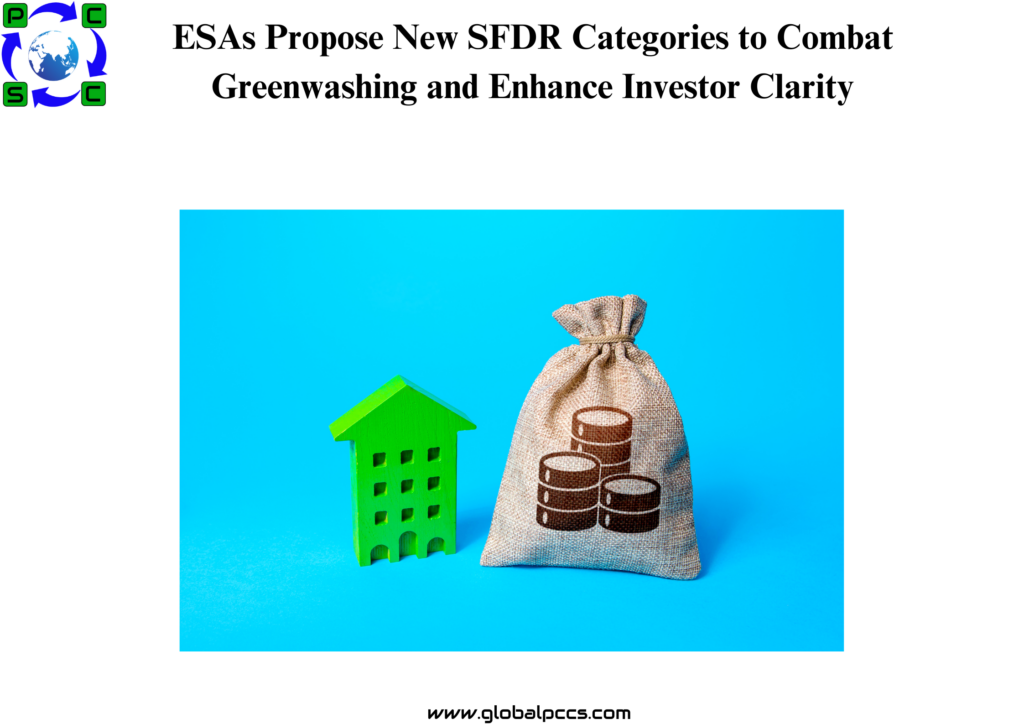 Summary
Summary
Under the Sustainable Finance Disclosure Regulation (SFDR), the European Supervisory Authorities (ESAs) have suggested new categories for financial products in an effort to combat greenwashing and provide investors with more information. In addition to improving consumer protection, the suggested categories “Sustainable” and “Transition” are meant to offer precise standards for sustainable investments.
Key Impact Points:
Introduction of new categories: “Transition” and “Sustainable” categories to increase transparency and lessen greenwashing.
Sustainability indicator:a new system to rank the sustainability features of financial items.
Enhanced disclosures: More stringent regulations for goods that have sustainable attributes to avoid deceptive advertising.
Significant revisions to the Sustainable Finance Disclosure Regulation (SFDR) have been suggested by the European Supervisory Authorities (ESAs). Among these improvements are the addition of the “Sustainable” and “Transition” categories for financial products. This action seeks to lower the danger of greenwashing and provide clarification on sustainability claims.
Background: The European Commission’s thorough assessment of the SFDR framework has prompted responses from the ESAs, which are the European Securities and Markets Authority (ESMA), the European Banking Authority (EBA), and the European Insurance and Occupational Pensions Authority (EIOPA). The goal of this assessment is to standardize financial market players’ disclosure requirements with relation to sustainability impacts and risks.
Current Concerns: Funds are now categorized by the SFDR under “Article 8,” which promotes environmental or social qualities, and “Article 9,” which has as its goal sustainable investment. These divisions have unintentionally evolved into de facto sustainability designations, which might give rise to greenwashing.
Proposals:
New Categories: Goods that invest in socially or ecologically sustainable initiatives and satisfy basic requirements such as EU Taxonomy alignment will fall under the “Sustainable” category. Product categories labeled “Transition” will include those that seek to eventually become sustainable. According to the ESAs, “the introduction of regulatory product categories would help generate clarity for investors, in particular retail investors, and address the greenwashing problems arising from the misuse of the disclosures under Article 8 and Article 9 of the SFDR.”
Sustainability Indicator: To make complicated sustainability information easier for customers to understand, a new indicator will be used to assess financial goods.
Enhanced Disclosures: Tighter disclosure guidelines and limitations on the use of ESG-related terminology in marketing will apply to items with sustainability elements that don’t fit into the new categories. Products lacking sustainability characteristics have to provide limited disclosure about their negative effects and disclaimers.
Challenges: The ESAs also emphasized the ambiguity brought up by the EU Taxonomy and SFDR’s similar definitions of “sustainable investment.” They propose that the Taxonomy may be used as a scientifically grounded benchmark for gauging sustainability success.
The evaluation conducted by the ESAs is a step in improving the SFDR framework, with the goal of producing sustainability disclosures and categories that are clearer, more dependable, and ultimately better for the environment and customers.
Contact for Free Consultation : https://docs.google.com/forms/d/e/1FAIpQLSeZ2qTHCfixqQLEBgEP9MhIB8Bx-Tp_eBy0V5noo0jJo8ZCiQ/viewform








 Authorised IMDS & CDX Training & Consulting partner for
Authorised IMDS & CDX Training & Consulting partner for






